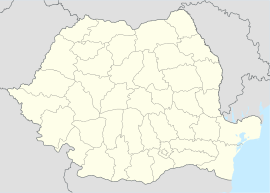world.wikisort.org - Romania
Ovidiu (Romanian pronunciation: [oˈvidju], historical name: Canara, Turkish: Kanara) is a town situated a few kilometres north of Constanța in Constanța County, Northern Dobruja, Romania. Ovidiu is quite small, with a population of around 12,000, and many wealthy inhabitants of Constanța retire there.[citation needed] It officially became a town in 1989, as a result of the Romanian rural systematization program.
Ovidiu | |
|---|---|
Town | |
 Ovidiu mosque | |
 Location in Constanța County | |
 Ovidiu Location in Romania | |
| Coordinates: 44°16′12″N 28°33′36″E | |
| Country | Romania |
| County | Constanța |
| Subdivisions | Poiana, Culmea |
| Government | |
| • Mayor (2020–2024) | George Scupra[1] (PNL) |
| Area | 82.63 km2 (31.90 sq mi) |
| Population (2011)[2] | 13,847 |
| • Density | 170/km2 (430/sq mi) |
| Time zone | EET/EEST (UTC+2/+3) |
| Vehicle reg. | CT |
| Website | www |
In 1930, the town was renamed Ovidiu after the Roman poet Ovid (Latin: Ovidius). He was supposedly buried on a nearby small island (also called Ovidiu) in the Siutghiol Lake.
Administration
The town of Ovidiu administers the villages of Poiana (historical names: Cocoșul - until 1964, Turkish: Horozlar - until 1926) and Culmea. The latter was established in 2011 by legally separating from Ovidiu two territorially distinct communities, Social Group Culmea and Social Group Nazarcea.
Sport
The stadium of FC Viitorul Constanța is located in Ovidiu.
Demographics
| Year | Pop. | ±% |
|---|---|---|
| 1992 | 12,591 | — |
| 2002 | 13,458 | +6.9% |
| 2011 | 12,342 | −8.3% |
| Source: Census data | ||
At the 2011 census, Ovidiu had 11,240 Romanians (91.07%), 3 Hungarians (0.02%), 229 Roma (1.86%), 3 Germans (0.02%), 358 Turks (2.90%), 396 Tatars (3.21%), 8 Lipovans (0.06%), 36 Aromanians (0.29%), 69 others (0.56%).
Natives
Gallery
- The Ovidiu island in the Siutghiol Lake
References
| Wikimedia Commons has media related to Ovidiu. |
- "Results of the 2020 local elections". Central Electoral Bureau. Retrieved 15 June 2021.
- "Populaţia stabilă pe judeţe, municipii, oraşe şi localităti componenete la RPL_2011" (XLS). National Institute of Statistics.
На других языках
[de] Ovidiu (Stadt)
Ovidiu ist eine Stadt im Kreis Constanța in der Region Dobrudscha (Dobrogea) in Rumänien.- [en] Ovidiu
[ru] Овидиу
Ови́диу (рум. Ovidiu, тур. Kanara) — город в жудеце Констанца, Добруджа, в Румынии. Административно городу также подчинено село Пояна (население 797 человек, 2002 год).Другой контент может иметь иную лицензию. Перед использованием материалов сайта WikiSort.org внимательно изучите правила лицензирования конкретных элементов наполнения сайта.
WikiSort.org - проект по пересортировке и дополнению контента Википедии


